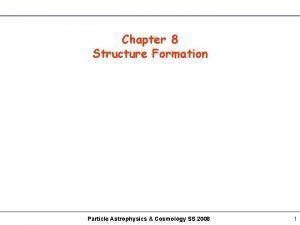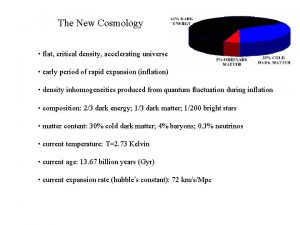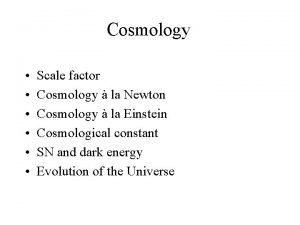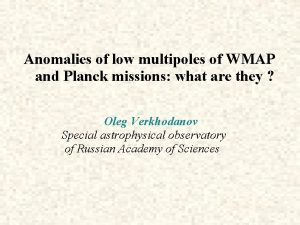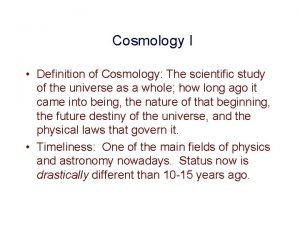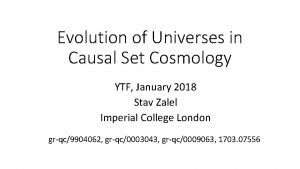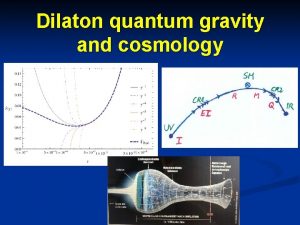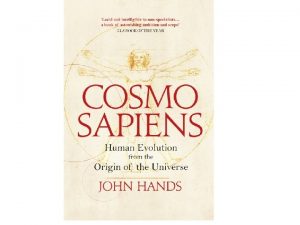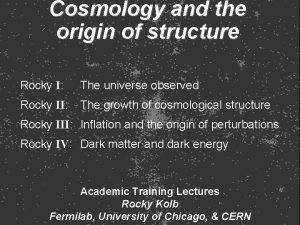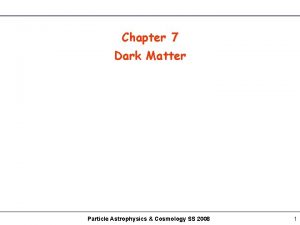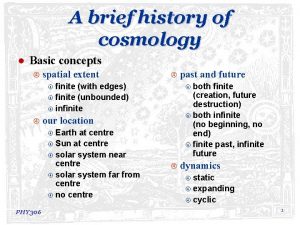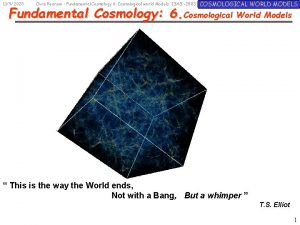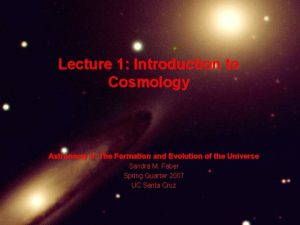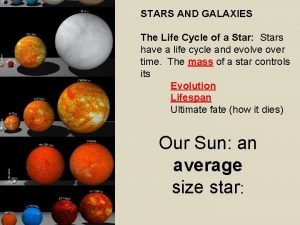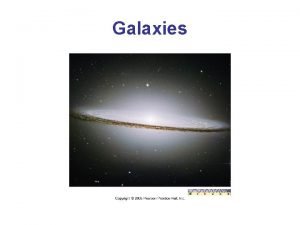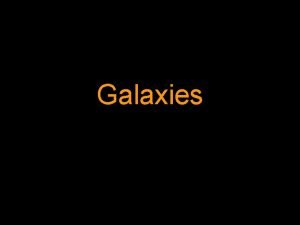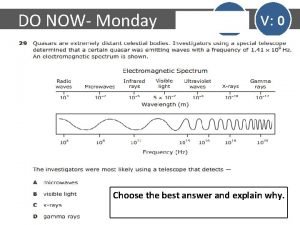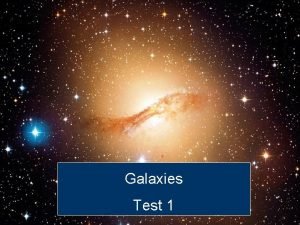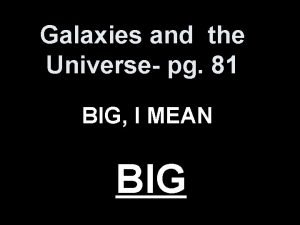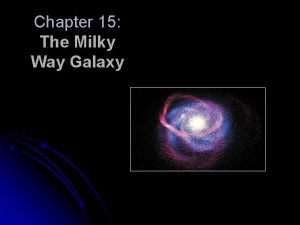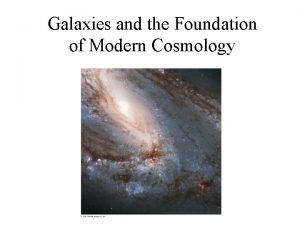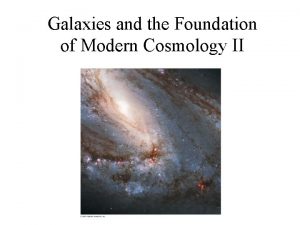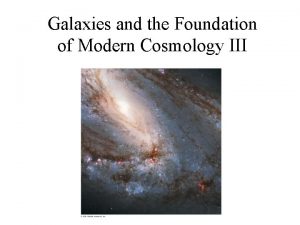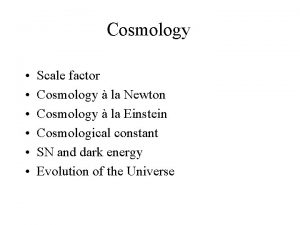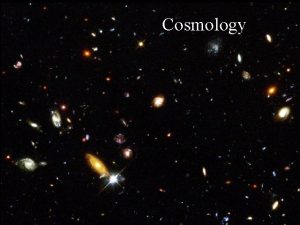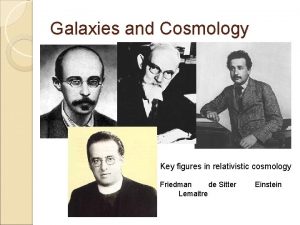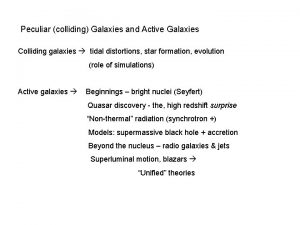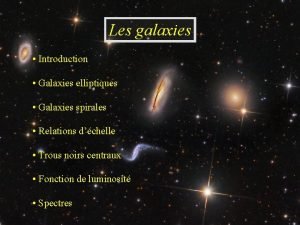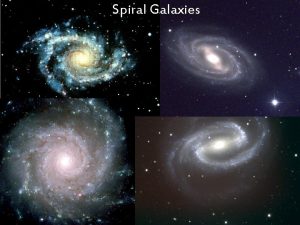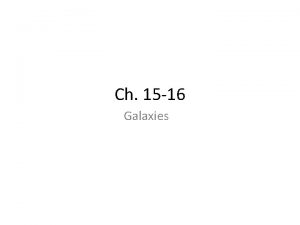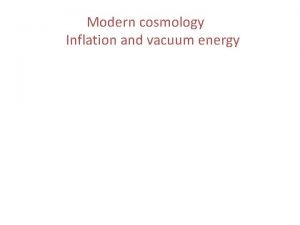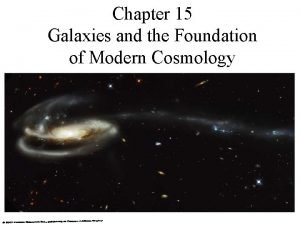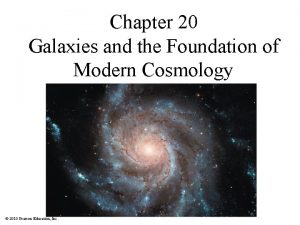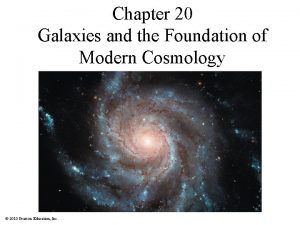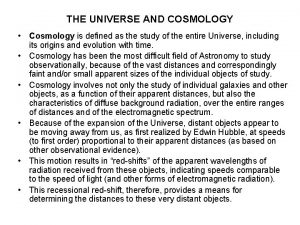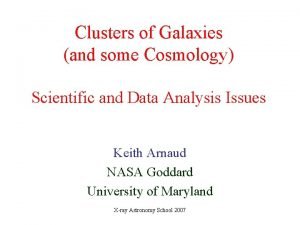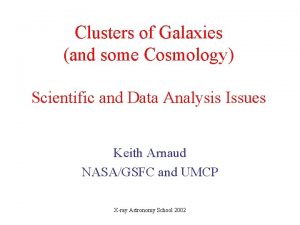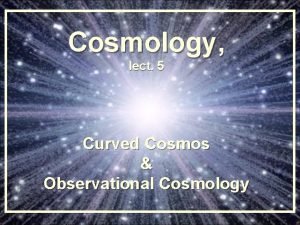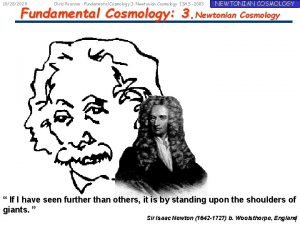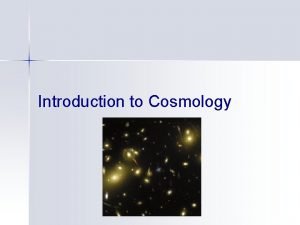Galaxies And the Foundation of Modern Cosmology What


















































- Slides: 50

Galaxies And the Foundation of Modern Cosmology

What are three major types of �galaxies?

Hubble Ultra Deep Field

Hubble Ultra Deep Field

Hubble Ultra Deep Field Spiral Galaxy

Hubble Ultra Deep Field Spiral Galaxy

Hubble Ultra Deep Field Elliptical. Galaxy Spiral Galaxy

Hubble Ultra Deep Field Elliptical. Galaxy Spiral Galaxy

Hubble Ultra Deep Field Elliptical. Galaxy Irregular Galaxies Spiral Galaxy

halo disk bulge Spiral Galaxy

Disk Component: stars of all ages, many gas clouds Spheroidal Component: bulge & halo, old stars, few gas clouds Type Sa Galaxy

Sa Galaxies: • Dominant nuclear bulge • Tightly wound spiral pattern • Few (but some) newly formed stars, HII regions or other evidence of active star formation

Sb Galaxies • Moderate nuclear bulge • Intermediate spiral pattern • Some evidence for massive young stars, HII regions, star formation

Type Sc Galaxy Disk Component: stars of all ages, many gas clouds Spheroidal Component: bulge & halo, old stars, few gas clouds Blue-white color indicates ongoing star formation Red-yellow color indicates older star population

Sc Galaxies (Some classify Messier as as Type Sd) • Small to nearly non-existent nuclear bulge • Open spiral pattern • Active star-formation

Disk Component: stars of all ages, many gas clouds Spheroidal Component: bulge & halo, old stars, few gas clouds Blue-white color indicates ongoing star formation Red-yellow color indicates older star population

Barred Spiral Galaxy Has a bar of stars across the bulge

Barred Spiral Types SBa SBb SBc

S 0 Lenticular Galaxy Has a disk like a spiral galaxy but very little dust or gas (intermediate between spiral and elliptical)

S 0 Edge-on Note the clear presence of a disk, but absence of dust band in this S 0 galaxy: NGC 3115

Elliptical Galaxy: All spheroidal (bulge) component, no disk

Elliptical Galaxy: All spheroidal component, virtually no disk component Red-yellow color indicates older star population

Irregular Galaxies Irregular I Galaxy Blue-white color indicates ongoing star formation

Irr II Galaxy - Messier 82

Spheroid Dominates Hubble’s Galaxy Classes Disk Dominates


How are galaxies grouped together?

Spiral galaxies are often found in groups of galaxies (up to a few dozen galaxies)

Our Galaxy & Andromeda belong to a small “Local Group” of about 20 or so galaxies

Elliptical galaxies are much more common in huge clusters of galaxies (hundreds to thousands of galaxies)

How do we observe the life histories of galaxies?

Deep observations show us very distant galaxies as they were much earlier in time (Old light from young galaxies)



Denser regions contracted, forming protogalactic clouds H and He gases in these clouds formed the first stars

Supernova explosions from first stars kept much of the gas from forming stars Leftover gas settled into spinning disk Conservation of angular momentum

Why do galaxies differ? NGC 4414 M 87 But why do some galaxies end up looking so different?


Nature: Conditions in Protogalactic Cloud? Spin: Initial angular momentum of protogalactic cloud could determine size of resulting disk

Conditions in Protogalactic Cloud? Density: Elliptical galaxies could come from dense protogalactic clouds that were able to cool and form stars before gas settled into a disk

Distant Red Ellipticals • Observations of some distant red elliptical galaxies support the idea that most of their stars formed very early in the history of the universe

We must also consider the effects of collisions

Collisions were much more likely early in time, because galaxies were closer together

Many of the galaxies we see at great distances (and early times) indeed look violently disturbed

The collisions we observe nearby trigger bursts of star formation

Modeling such collisions on a computer shows that two spiral galaxies can merge to make an elliptical

Modeling such collisions on a computer shows that two spiral galaxies can merge to make an elliptical

Shells of stars observed around some elliptical galaxies are probably the remains of past collisions

Collisions may explain why elliptical galaxies tend to be found where galaxies are closer together

Giant elliptical galaxies at the centers of clusters seem to have consumed a number of smaller galaxies
 Electromagnetic star
Electromagnetic star Chapter 30 galaxies and the universe
Chapter 30 galaxies and the universe Elliptical spiral and irregular
Elliptical spiral and irregular Cosmology
Cosmology Critical density
Critical density Scale factor cosmology
Scale factor cosmology Axis of evil cosmology
Axis of evil cosmology Definition of cosmology
Definition of cosmology Stav zalel
Stav zalel Dilaton
Dilaton Concordance model of cosmology
Concordance model of cosmology Cosmology
Cosmology Cosmology
Cosmology Newton cosmology
Newton cosmology Cosmology
Cosmology Intro to cosmology
Intro to cosmology Jain geography
Jain geography Life cycle of galaxies
Life cycle of galaxies Elliptical galaxies facts
Elliptical galaxies facts Th eirregulars
Th eirregulars The pity relation for an adiabatic expansion is
The pity relation for an adiabatic expansion is Critical density
Critical density What are galaxies
What are galaxies Brainpop galaxies quiz answers
Brainpop galaxies quiz answers 4 types of galaxies
4 types of galaxies How are active galaxies classified?
How are active galaxies classified? Tipus de galaxies
Tipus de galaxies Properties of elliptical galaxies
Properties of elliptical galaxies Evolution of galaxies
Evolution of galaxies Universe pg
Universe pg Galaxies lesson plan
Galaxies lesson plan Pad foundation section
Pad foundation section Composition of urine slideshare
Composition of urine slideshare Hình ảnh bộ gõ cơ thể búng tay
Hình ảnh bộ gõ cơ thể búng tay Frameset trong html5
Frameset trong html5 Bổ thể
Bổ thể Tỉ lệ cơ thể trẻ em
Tỉ lệ cơ thể trẻ em Gấu đi như thế nào
Gấu đi như thế nào Glasgow thang điểm
Glasgow thang điểm Hát lên người ơi alleluia
Hát lên người ơi alleluia Các môn thể thao bắt đầu bằng tiếng đua
Các môn thể thao bắt đầu bằng tiếng đua Thế nào là hệ số cao nhất
Thế nào là hệ số cao nhất Các châu lục và đại dương trên thế giới
Các châu lục và đại dương trên thế giới Công của trọng lực
Công của trọng lực Trời xanh đây là của chúng ta thể thơ
Trời xanh đây là của chúng ta thể thơ Mật thư anh em như thể tay chân
Mật thư anh em như thể tay chân Làm thế nào để 102-1=99
Làm thế nào để 102-1=99 Phản ứng thế ankan
Phản ứng thế ankan Các châu lục và đại dương trên thế giới
Các châu lục và đại dương trên thế giới Thơ thất ngôn tứ tuyệt đường luật
Thơ thất ngôn tứ tuyệt đường luật Quá trình desamine hóa có thể tạo ra
Quá trình desamine hóa có thể tạo ra



